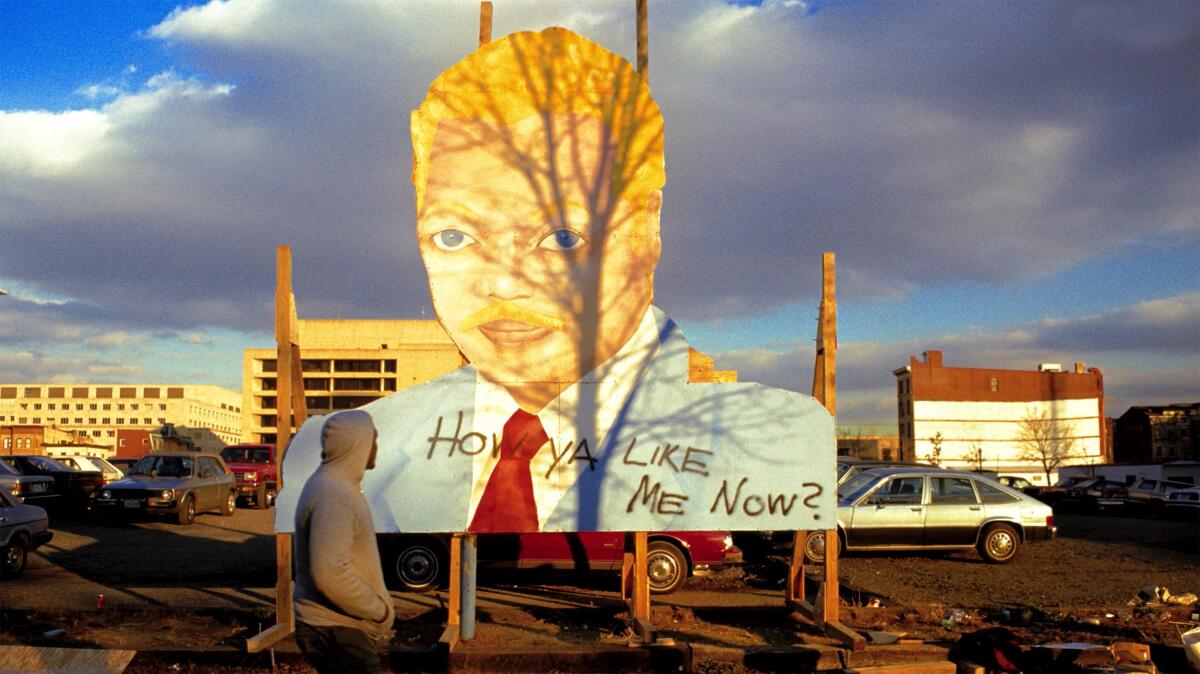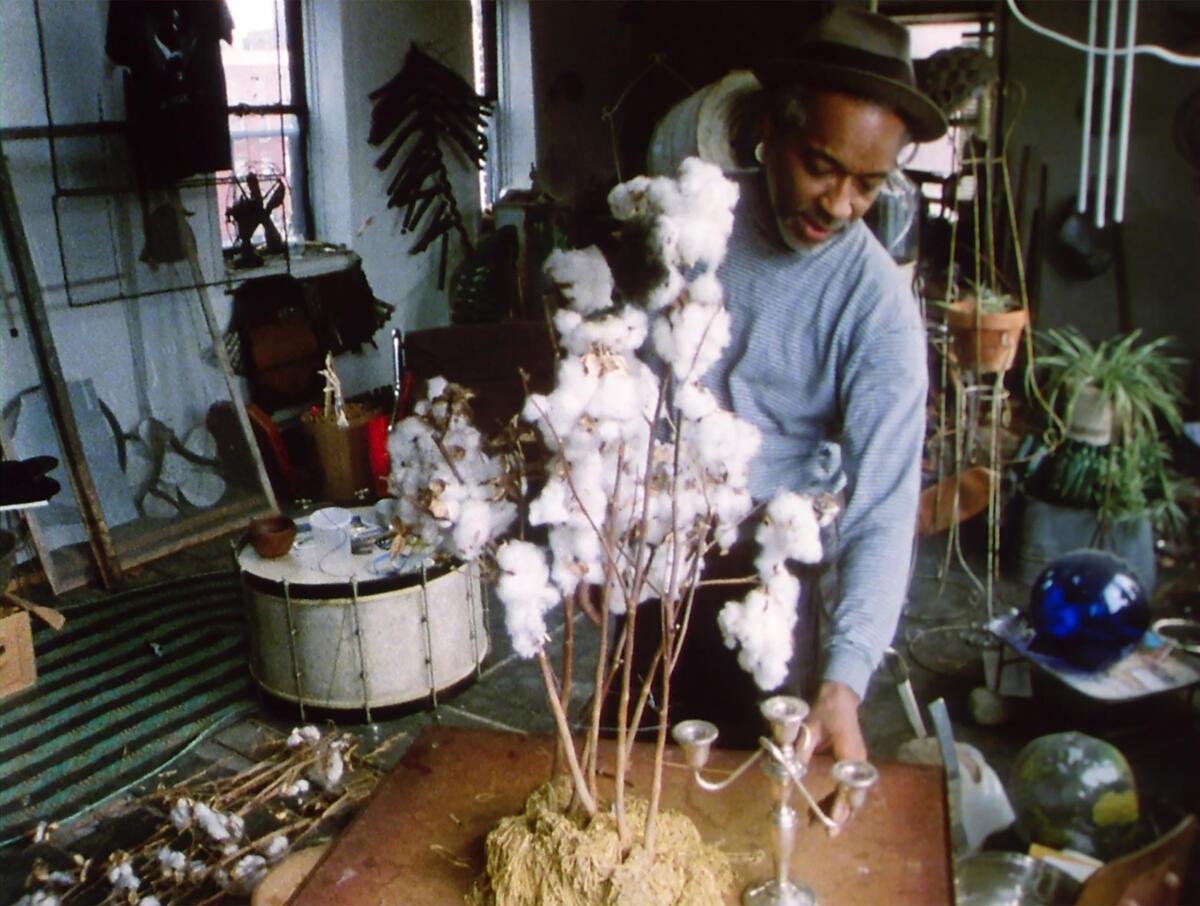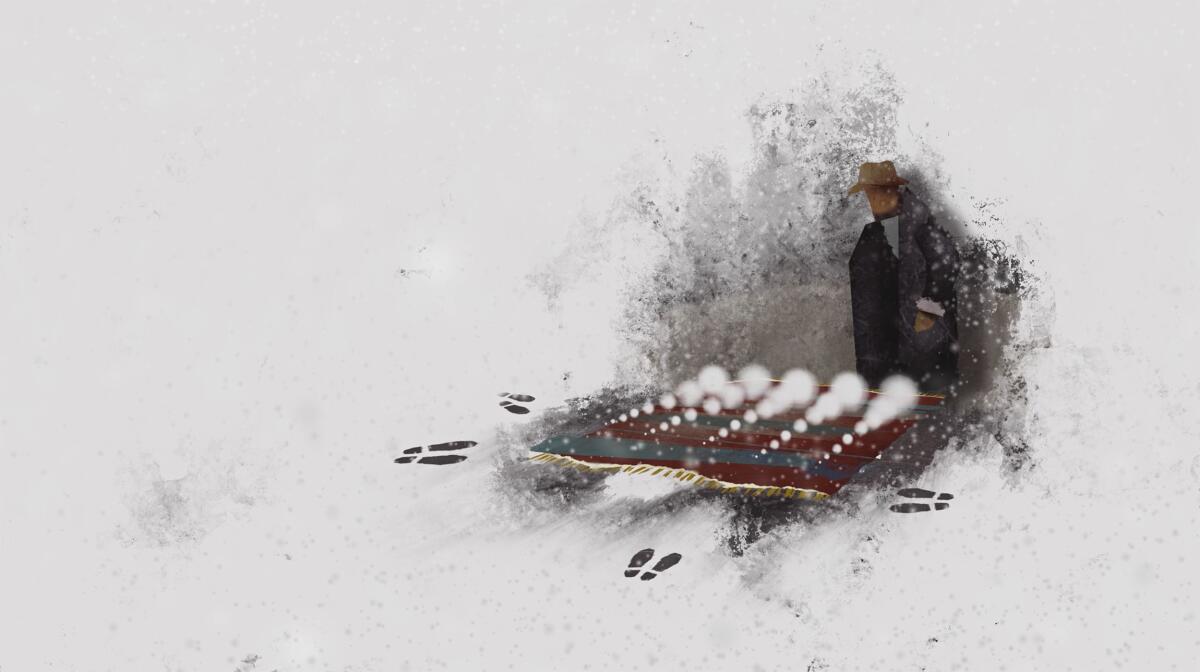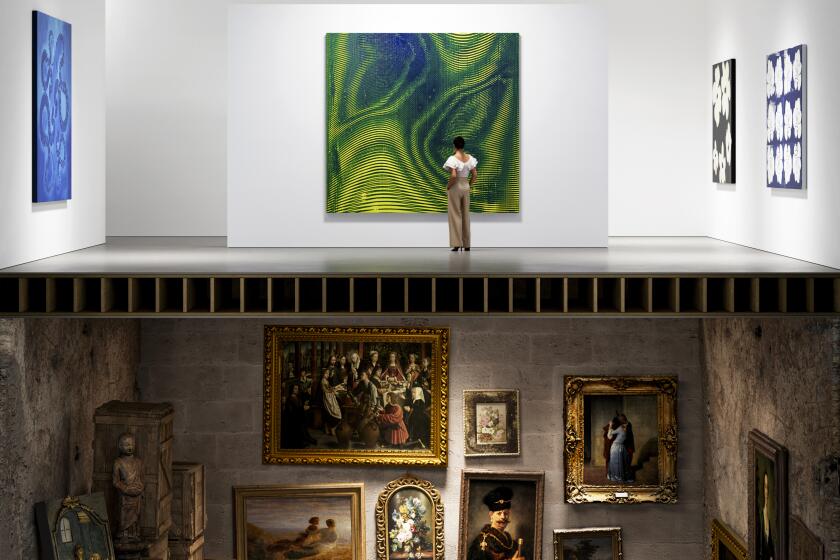Review: David Hammons is one of our greatest living artists. An absorbing new documentary explains why

- Share via
In David Hammons’ most disarming art, seeming simplicity assumes sharp sophistication. It’s like a supercharged matryoshka doll, with each layer peeling back to reveal and fertilize another layer — and another, and another, and another, until a viewer is dizzy with exhaustion, both delightful and chastening.
Black life in a white-dominated society has been Hammons’ focus for more than half a century, at least since the fateful year of 1968. That’s when he enrolled in what is now called Otis College of Art and Design to work with artist Charles White, back when the school was at the edge of L.A.’s MacArthur Park (the one that was then melting in the dark, all the sweet green icing flowing down). Today, at 79, Hammons is among our greatest living artists. His work is nothing less than a cultural touchstone for critical developments at the center of American art and life.
A documentary film about a living artist is especially difficult to do when the subject won’t participate, including not sitting for an interview. That’s one reason why “The Melt Goes on Forever: The Art & Times of David Hammons” is noteworthy. The film is absorbing anyhow, minus the artist’s retrospective musings, thanks to contributions from many smart and observant artists and others.
Hammons shows up now and then in rare documentary footage, which only adds to a distanced sense of disregard for norms that has been central to his aesthetic. That includes general indifference to the current clamor for celebrity driving so much contemporary culture.
Surely the film’s well-established co-directors — Judd Tully, a longtime New York art writer, and Harold Crooks, an award-winning Canadian filmmaker — assumed before they started that they’d have to do without the artist’s direct contribution to their 2022 documentary. (It finally arrives Friday in Los Angeles at the Laemmle Monica Film Center, jumping to Amazon and Apple TV on July 5.) Hammons is famously elusive. I met him only once, in 1991, as he was finishing up a few minor details on the installation of a terrific midcareer survey at the Museum of Contemporary Art, San Diego. He was congenial, we exchanged pleasantries, and he was gone. The show, on the other hand, spoke with dazzling, sometimes strangely confounding eloquence.
That it was happening in the super-wealthy, almost entirely white enclave of La Jolla threw everything into glaring high relief. For example, a 1991 basketball hoop made from a plastic milk crate atop a pole studded with bottle caps, like a ceremonial staff, became a jarring aspirational symbol for a potential escape from poverty. An elegantly fanned, undulating 1982 wall relief was made from flattened brown paper bags smeared with chicken fat and flecked with Black hair (title: “Bag Lady in Flight”).

Greeting visitors at the entry, and incisively chronicled in the film, was the shocking 1988 installation “How Ya Like Me Now?” The battered remains of a Hammons billboard feature an image of Jesse Jackson in whiteface, blond and blue-eyed, which the artist originally erected on the street facing the National Portrait Gallery — our official hall to celebrate citizen achievement, yet a museum where Black faces are largely absent.
Resistance, sometimes in the form of brash mockery, is an operating engine for Hammons’ art. Resistance to the demands of white society. Resistance to conventional art materials (his sculptures have been made from frying pans, rocks, barbershop hair, chicken bones, fur coats and snow.) Resistance to the public relations mill. Resistance to expectation and easy understanding.
Hammons moved to Harlem in 1974 — a place rich in ruins, he said, like Rome — but pivotal to his development were the six previous years he spent in Los Angeles (he was born in Springfield, Ill., in 1943, and joined the Great Migration). At Otis, the unblinking social realism embodied in White’s monumental drawings was essential. (When Hammons moved to New York, downtown poet Steve Cannon would assume White’s mentor role.) Nearby, at the Granada Buildings on Lafayette Park Place, artist Suzanne Jackson’s Gallery 32 offered community for Black artists. Among the more than 30 people interviewed for the documentary, Jackson (herself a former White student) and art historian Kellie Jones, who organized the decisive 2011 UCLA Hammer exhibition “Now Dig This! Art and Black Los Angeles, 1960-1980,” are two of the more penetrating voices.
LACMA might be a de facto museum of contemporary art, but frankly it’s not a very good one.
Perhaps the documentary’s most salient point, and one that can be hard to wrap your head around, is the relationship between Hammons’ art and that of Marcel Duchamp (1887-1968). The French Dadaist’s work was the platform on which Pop and Conceptual art were built in the late 1950s and ’60s, and Duchamp’s conception of the “readymade” was its beating heart.
In modern industrial culture, the sharp distinction between a work of art and a machine-fabricated object — something already made — became blurry. Duchamp proposed that a metal rack for drying used wine bottles at a cafe, an ordinary hardware-store snow shovel or a plain bathroom urinal could all do double duty as sculptures. What mattered was how a viewer looked at them, and maneuvering that angle of vision into an unexpected point of view was the artist’s job.
Hammons looked at Duchamp, he looked at Black American life, he looked at how white art people looked at Duchamp and at Black Americans — and he looked askance. His work soon infused the specter of mortality into the burgeoning legacy of Duchampian art-puns.

That bourgeois cafe wine rack? Several dozen empty wine bottles, amounting to a derelict’s boozy remains, were glued together into a loop that holds a battered bucket aloft. Hammons’ sculpture gives an elegantly redeemed frame of reference to an unhoused lost soul drenched in cheap wine and likely to “Kick the Bucket” on the street, as he titled it.
Duchamp’s tipped-over bathroom urinal? Hammons executed a one-man street action by relieving himself in public against a prominent brute sculpture of mammoth steel walls by Richard Serra. (A policeman intervened.) Near a subway station entrance on a busy traffic island, the gesture transformed a private function accommodated by Duchamp’s found object into a desperate social act, which Hammons titled “Pissed Off.”
“I’m the CEO of the DOC — the Duchamp Outpatient Clinic,” Hammons once joked. The documentary notes that his art’s conceptual hurdle, which is anything but comic, is that the ultimate ready-made is the Black enslaved person — flesh-and-blood personhood industrialized, stripped of nature’s ordinary miracle, made into a dehumanized “found object.”
Nowhere is that cruelty more evident than in a now-legendary work referred to in the film’s astutely chosen title, “The Melt Goes on Forever.” Snowballs are the centerpiece. Tangentially related to Duchamp’s snow shovel, which the Frenchman wittily titled “In Advance of a Broken Arm,” Hammons set up his piece on a wintry East Village sidewalk near the corner of Cooper Square and Astor Place in 1983. The racist Reagan era’s greed-is-good economic nastiness was rapidly unfolding. “Bliz-aard Ball Sale I” called up a snooty, knowingly pretentious pronunciation, forced by the spelling of bliz-aard, to speak of broken men and women.
The piece consisted of ordinary snowballs in graduated sizes that Hammons spread out on a blanket and offered for sale at tiered prices, depending on size. It formed a nominal “sculpture gallery” featuring Postminimal objects handmade by an artist. The array took its place amid other blankets displaying survival-mode street merchandise — used paperbacks, knockoff designer handbags, battered junk — being sold by people in dire circumstances. Disconcerted passersby didn’t quite know what to make of it, all those crisp white spheres forming an arsenal of fun. A jarring clang of cruelty and playfulness cohabit in a single work.
The snowball street action, unannounced by press release or other notice at the time, is mostly known today through documentary photographs taken by Hammons’ friend, artist Dawoud Bey. (With fellow artist Carrie Mae Weems, Bey’s work is the subject of a current photography exhibition at the J. Paul Getty Museum, through July 9; a solo survey is also at Sean Kelly Gallery in Hollywood, through June 30.) The film adds a radiant animation by Tynesha Foreman. One puzzled onlooker passing by that day is now a past president of the Art Dealers Assn. of America; the documentary reports his quixotic attempt years later, after the artist was an international figure, to buy an ephemeral Hammons snowball for a million dollars.
There will be no spoiler here to that mind-boggling story and its unexpected twists and turns. But it frames the larger narrative of a supremely gifted Black artist, moving through a white-dominated art world awash in ever-larger piles of cash, as a tale of humanity brutalized by stony economic transactions. In that, “The Melt Goes on Forever: The Art & Times of David Hammons” reverberates against the founding sins of U.S. history, which remain painfully operative today.
“The Melt Goes on Forever: The Art & Times of David Hammons”
Where: Laemmle Monica Film Center, 1332 2nd St., Santa Monica
When: Friday
Running time: 101 minutes
Info: themeltfilm.com
More to Read
The biggest entertainment stories
Get our big stories about Hollywood, film, television, music, arts, culture and more right in your inbox as soon as they publish.
You may occasionally receive promotional content from the Los Angeles Times.












